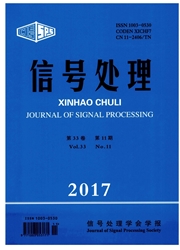

 中文摘要:
中文摘要:
稀疏表示、不相关观测和重构是影响压缩感知性能的三大要素,本文设计的自适应观测矩阵以高斯随机观测阵为初始矩阵,利用信号稀疏域系数的部分先验信息进行自适应变换,形成新的观测阵,当压缩感知矩阵对信号的稀疏系数进行投影时,可使得稀疏系数中的小系数更接近于零;同时,通过减少观测阵行向量的方式来减少观测值,从而应用自适应观测阵后的数据传输量与用高斯随机矩阵的数据传输量相差不大。自适应观测矩阵对压缩感知的性能改进体现在重构精度上,用迭代硬阈值算法作为重构算法,我们从理论和实验仿真两方面验证了自适应观测阵的性能要优于高斯随机矩阵。
 英文摘要:
英文摘要:
Sparse representation, incorrelate projection and reconstruction are the three elements of compressed sensing, This paper uses Gaussian random matrix as original matrix, and adaptively transforms using the partial positional information of sparse coefficients, then forms a new adaptive measurement matrix. When the compressed sensing matrix projects the sparse coefficients, the small coefficients are more close to zero; at the same time, we decrease the measured values by re- ducing the columns of measurement matrix, thus the difference between the amount of data transmission using adaptive measurement matrix and the amount of data transmission using Gaussian random measurement is little. The improved per- formanee of compressed sensing employed adaptive measurement matrix embodies in the reconstruction accuracy. When we use iterative hard thresholding as reconstruction algorithm; both theory and experiment verify the performance of adaptive measurement matrix better than Gaussian random measurement matrix.
 同期刊论文项目
同期刊论文项目
 同项目期刊论文
同项目期刊论文
 期刊信息
期刊信息
